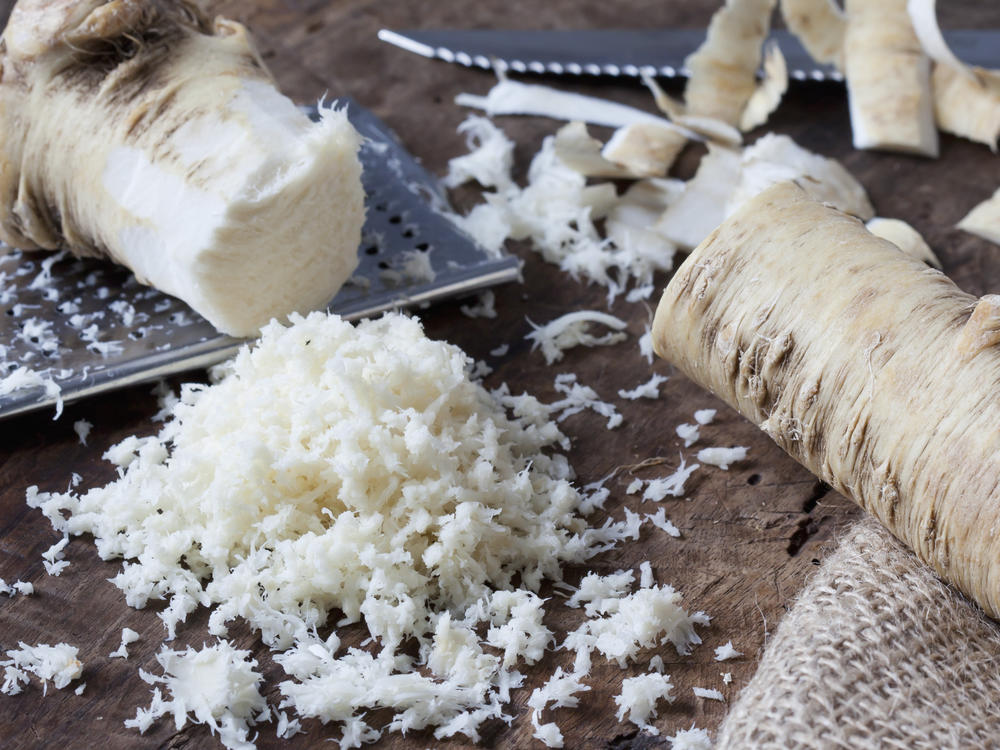Section Branding
Header Content
The Sting That Cuts Through Numbness: Horseradish On Pandemic Passover Tables
Primary Content
Grating horseradish is serious business. The volatile oil that's released can cut right through you.
Leah Koenig, who has written six Jewish cookbooks, knows that firsthand.
"It kind of goes into your nose, and up into nasal cavities, and you kind of feel like you're getting a cleanse going on," Koenig laughs, "but not a pleasant one."
She has friends who wear gas masks or protective goggles when they prepare the root.
Koenig has developed horseradish recipes in which it's mixed with vinegar to preserve its sharpness before it dissipates. But for her own Passover Seder, she borrows a trick from her in-laws, and cuts a fresh root into little matchsticks.
Horseradish will be on many Seder tables Friday night, symbolizing the bitterness ancient Hebrews experienced during slavery in Egypt. It's part of the participatory ritual that is the Seder — something people do, and eat, and ask, to bring the past to life at the table.
The Hebrew word for bitter herb, maror, comes from the same linguistic root of the word that's used to describe how Egyptians "embittered" the lives of the people they enslaved. And by eating it, participants are supposed to feel that hardship.
"You have this moment where you are feeling physical pain during the Seder," Koenig says. "And whether or not you're specifically connecting that to how your ancestors felt, you are going through that moment."
But that moment hasn't always been marked with the horseradish.
Joshua Kulp, head of the Conservative Yeshiva in Jerusalem, says that the bitter herbs on the Seder plate tell not only the story of the exodus from Egypt, but the story of the Jewish people in the diaspora.
"We can kind of trace Jewish history through what we eat for that bitter herb," Kulp says. "And our origins are in the Torah as wandering nomadic people — shepherds, really."
The Torah doesn't specify which bitter herbs. Kulp figures these shepherds probably grabbed some sprigs of oregano or hyssop or wild thyme. But by the second century C.E., Jews weren't shepherds. They were in Israel, under Greek and Roman rule.
"And when you look at the authoritative texts of Judaism, the Talmud identifies the bitter herb as lettuce. Which is surprising for a lot of people," Kulp says.
It wouldn't be surprising for Sephardim, the Jews of the Spanish and Portuguese empires. They kept lettuce as their bitter herb, and their descendants still eat it during Passover Seders. But for those who moved into Central and Eastern Europe, there was no lettuce this time of year.
"So the horseradish began in about 14th century Germany," Kulp explains. "Originally they only ate the leaves. And you find all sorts of interesting discussions continuing all the way through the 18th, 19th centuries concerning how much horseradish you have to eat. Can you grate it?"
When Kulp first learned this history, he was happy to add lettuce to his Seder table — and was surprised when his family rebelled. And now he has both at his Passover table.
"I serve the horseradish because it just doesn't feel like a Seder without the horseradish. I really think the way we act in life isn't what's written in a book," Kulp says. "It's what we learned from our parents. It's what we learned from our grandparents. It's what makes us feel Jewish."
For many American Jews, horseradish feels right because they're descended from Central and Eastern Europe immigrants, who came to America in large waves during the late 19th and early 20th centuries.
Nora Rubel, chair of the religion department at the University of Rochester, says you find recipes with horseradish in the earliest American Jewish cookbooks, which makes sense. Jewish civilization flourished in Europe for centuries.
"Horseradish was very prevalent in German cooking, and I think that is what became a standard in what was seen as American Jewish food early on in Jewish American migration," Rubel says.
On her Seder table, Rubel will feature fresh horseradish, as well as what she calls "maror shots" — horseradish-infused vodka. Of course, this particularly preparation isn't mentioned in any of the rabbinic texts. But Rubel argues alcohol, like the vinegar of prepared horseradish, is just another way of preserve those punchy compounds.
"I'm doing what my ancestors would have done," Rubel jokes.
But whatever form the bitter herbs take, some argue that harshness and pain isn't a feeling people need much help accessing right now, on this second pandemic Passover.
"I don't think I need the bitter herbs this year," laughs food writer Leah Koenig. "I think I'm there already. And I think my bitterness, it's less sharp than horseradish this year. My bitterness is more muted."
Koenig, like a lot of people, hasn't had time to feel the full grief of what she's lost over the past year. She's been locked down with her family in a Brooklyn apartment, trying to work, checking in on her mom, and waiting to hear each day if elementary school is on quarantine again. It's how people get through the days. How they've gotten through this year, if they've been lucky.
"So maybe when I bite into that horseradish, I will be shaken into feeling something," Koenig says.
Rituals change as the people who make them change. From lettuce to horseradish. Ancient Hebrews to 21st century Americans. Lockdown to normal life. And as Jews taste whatever bitter symbols are on their Seder plates tonight, they'll feel something. It could be the full weight of this past year, the sharpness of the grief. Or it could be the fresh shoots of freedom, and the spring that's just starting to emerge.
Copyright 2021 NPR. To see more, visit https://www.npr.org.

